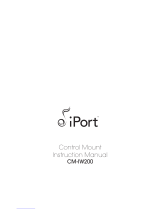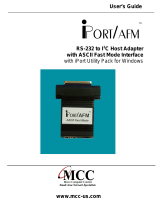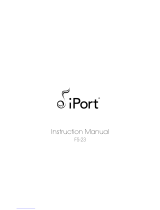Page is loading ...

I-8172/71 User’s Manual (Ver.1.2, Feb/2006) ----- 1
I-8172(H)/71(H)
User’s Manual
Warranty
All products manufactured by ICP DAS are warranted
against defective materials for a period of one year from the
date of delivery to the original purchaser.
Warning
ICP DAS assumes no liability for damages consequent to
the use of this product. ICP DAS reserves the right to change
this manual at any time without notice. The information
furnished by ICP DAS is believed to be accurate and reliable.
However, no responsibility is assumed by ICP DAS for its use,
not for any infringements of patents or other rights of third
parties resulting from its use.
Copyright
Copyright 2004 by ICP DAS. All rights are reserved.
Trademark
The names used for identification only may be registered
trademarks of their respective companies.
Web Site:
http://www.icpdas.com

I-8172/71 User’s Manual (Ver.1.2, Feb/2006) ----- 2
Tables of Contents
1. INTRODUCTION.............................................................3
1.1 F
EATURES.....................................................................6
1.2 S
PECIFICATIONS............................................................8
1.3 O
RDERING INFORMATION...............................................9
1.3.1 Options......................................................................9
1.4 P
RODUCT CHECK LIST .................................................10
2. HARDWARE CONFIGURATION .................................11
2.1 I
NTERNAL I/O STRUCTURE...........................................11
2.2 P
IN ASSIGNMENTS.......................................................12
3. SOFTWARE FUNCTIONS ...........................................13
3.1 I-8000
CONTROLLERS .................................................13
3.2 W
INCON-8000 CONTROLLERS .....................................15
4. FRNET APPLICATION STRUCTURE .........................16

I-8172/71 User’s Manual (Ver.1.2, Feb/2006) ----- 3
1. INTRODUCTION
FRnet is a two-wire serial communication bus and is wired in a
similar manner as the RS-485. FRnet devices connect to the
communication by using the multi-drop method. Unlike most
communication methods based on RS-485, FRnet does not use the
traditional question/answer approach. Instead, it uses special chips
to actively transmit data with a fixed scan time. Since there is no
need of a CPU to process a communication protocol, FRnet can
achieve high-speed data transmission in an isochronous manner.
The I-8172/72H/71/71H is an isolated FRnet communication
module designed for use in WinCon, LinCon and I-8000 controllers.
I-8171 module has one FRnet port whereas the I-8172 module has
two FRnet ports. Each FRnet port has 8 sender nodes and 8
receiver nodes. That is, the node address setting is defined as
SA0~SA7 and RA8~RA15. Each node contains 16-bit data, which
can be either a DI or DO type depending on what module you use.
Therefore, it can control up to a maximum of 128 (= 16*8) digital
output channels and 128 (= 16*8) digital input channels with a total
scan time of 2.88ms for 250kbps or 0.72ms for 1Mbps (for the H
version).
Note: The H version modules can not work together with the
normal speed modules.

I-8172/71 User’s Manual (Ver.1.2, Feb/2006) ----- 4
I/O data transmission of the FRnet communication is controlled
by the FRnet control chip which was developed by ICPDAS. It is
designed to provide a deterministic high speed communication for
this network. This communication mechanism is dominated by the
token stream, which is generated by the network manager (located
at SA0 node). It provides a fixed scan-time for I/O synchronization
without special communication protocol. Furthermore, special anti-
noise circuitry has been built into the FRnet control chip to ensure
communication reliability.
However, the effectiveness of the FRnet depends on and is then
ensured when the correct hardware configurations for the sender
address (SA) and receiver address (RA) on the host controller and
the remote module in the network have been installed properly. In
general, the operating principle is structured by the strategy of
delivering the 16-bit data from the specified sender address (SAn)
to the corresponding receiver address (RAn) via the broadcasting
method controlled by the token-stream of the network manger, SA0.
Based on this algorithm, there are some general rules that need to
be followed:
(1) The sender address needs to be unique in order to avoid any
communication collisions.
(2) Each of FRnet bus needs one and only one network manger
defined as SA0. It plays the important role of producing the
token-stream in the network.

I-8172/71 User’s Manual (Ver.1.2, Feb/2006) ----- 5
(3) The baud rates of the controller and the remote module need
to be the same as on the FRnet.
(4) The communication method is controlled by delivering the
data of the specified sender address (SA) to the
corresponding receiver address (RA) in the sequence of
token 0 to (N-1) cyclically, as depicted below.
(5) Due to the broadcasting algorithm adopted, the receiver
address is not required to be unique. Therefore, it is easy to
build in data delivery from one node (16-bit data) to a multi-
node.
Figure 1.1 Token stream controlled by network manger, SA0
Each port of I-8172/71 host module contains nodes from SA0~7
and RA8~15. That means each port on I-8172/71 can connect to
devices which have node addresses set between RA0~7 and
SA8~15. The RA node on device can receive the command data
from host module. Therefore, remote FRnet DO modules must have

I-8172/71 User’s Manual (Ver.1.2, Feb/2006) ----- 6
RA nodes. In a similar way, the remote FRnet DI modules must
have SA nodes. The registers of SA and RA nodes on the host are
mapped to a region of host’s memory. Users can easily control the
FRnet I/O module through reading and writing the specified memory
located on the host computer.
Figure 1.2 FRnet application structure
1.1 Features
The Token stream is used to activate data transmission from the
specified SA node to the corresponding RA nodes.
The Network Manager is defined as SA0. Each of FRnet must
have SA0 because it issues the Token stream into the network.
The Token stream is produced cyclically by hardware at the
fixed time interval, see Figure 1.1. Therefore, the FRnet I/O

I-8172/71 User’s Manual (Ver.1.2, Feb/2006) ----- 7
system can provide both the isochronous and deterministic
functionalities.
It can provide data transmission from one node (SA) to remote
multiple nodes (RA) at the same time. It implies that the SA
address must be unique, but the RA address can be different or
the same in the network.
The FRnet system can be easily extended by adding new
modules to the network.
Device Inter-communication: A single device can talk to other
devices by setting appropriate SA and RA node configurations.
Adopt Memory-mapping technology to control I/O nodes.
No software overhead: all data transmissions are performed
automatically via the FRnet control chips. Therefore, there is no
need for the CPU to process transmission protocols.
It only needs simple RS-485 wiring method.
OS (operation system) independent.

I-8172/71 User’s Manual (Ver.1.2, Feb/2006) ----- 8
1.2 Specifications
Table 1.1 Characteristics of the I-8172
I-8172/71 I-8172H/71H
Transfer speed 250Kbps 1Mbps
Scan time 2.88ms 0.72ms
Max transfer length 400 m 100 m
Table 1.2 I/O Address of I-8172
I-8172/H I-8171/H
I/O Address
for Port 0
SA [0]~[7] ,
RA [8]~[15]
SA [0]~[7] ,
RA [8]~[15]
I/O Address
for Port 1
SA [0]~[7] ,
RA [8]~[15]
Not Available
Note: SA: Sender Address of a node,
RA: Receiver Address of a node.
General specifications:
• Operation temperature: -25°C~+75°C
• Storage temperature: -30°C~+80°C
• Humidity: 5~95%
• Power consumption: 2 W(Max)

I-8172/71 User’s Manual (Ver.1.2, Feb/2006) ----- 9
1.3 Ordering information
• I-8172 : 250Kbps (2 Ports: SA 0~7, RA 8~15)
• I-8171 : 250Kbps (1 Port : SA 0~7, RA 8~15)
• I-8172H: 1Mbps (2 Ports: SA 0~7, RA 8~15)
• I-8171H: 1Mbps (1 Port : SA 0~7, RA 8~15)
Note: the high-speed version can be selected by an internal jumper.
1.3.1 Options
z FR-2057 series: 16-channel Isolated Digital Output Distributed
I/O Module.
z FR-2053 series: 16-channel Isolated Digital Input Distributed I/O
Module.
z DN-20/1m: Terminal board with two 20-pin flat cables (CA2010).
z FR-8R/16R/32R: 8/16/32-channel relay output terminal board.
z FR-8P/16P/32P: 8/16/32-channel photo-isolated input terminal
board.
z FR-8A/16A/32A: 8/16/32-channel Open drain output terminal
board.
z Other FRnet modules: Please refer to the web site of ICP DAS.

I-8172/71 User’s Manual (Ver.1.2, Feb/2006) ----- 10
1.4 Product Check list
In addition to this manual, this package should include the following
items:
• One I-8172/71 module
• One copy of the release notes
Before continuing, please read the release notes first. They
contain the following important information.
1. The location of the software driver and utility
2. FAQ’s
Attention!
If any of these items are missing or damaged, contact the
dealer from whom you purchased the product. Save all
shipping materials and the carton in case you need to ship or
store the product in the future.

I-8172/71 User’s Manual (Ver.1.2, Feb/2006) ----- 11
2. HARDWARE CONFIGURATION
2.1 Internal I/O Structure
Figure 2.1 Function blocks of the I-8172/71

I-8172/71 User’s Manual (Ver.1.2, Feb/2006) ----- 12
2.2 Pin Assignments
I-8172 module has two FRnet ports (similar to RS-485 ports). The
definitions of the pins on the connectors for the FRnet ports are
shown in the following Table.

I-8172/71 User’s Manual (Ver.1.2, Feb/2006) ----- 13
3. SOFTWARE FUNCTIONS
3.1 I-8000 Controllers
BC and TC users can use i8172_Init(), i8172_Write_DO_Group()
and i8172_Read_DI_Group() functions to control the FRnet DI/O.
The necessary step and function description are as follows.
1. Add “#Include “i8172.h” to the header of project.
2. Function Lists:
int i8172_Init (int iSlot);
/******************************************************
Use this function to initialize the assigned module.
iSlot: 0 ~ 7
return: 0: OK; -1: Error
*******************************************************/
void i8172_Write_DO_Group (int iSlot, int iPort,
int iGroup, unsigned int iData);
/**********************************************************
Use this function to write value to DO module.
iSlot: 0 ~ 7
iPort: 0 or 1
iGroup: 0 ~ 7
iData: Every group has 16 DO channels.
Each bit in iData sets a DO value.
***********************************************************/
void i8172_Write_DO_Bit(int iSlot, int iPort, int iGroup,
int iBit, int iStatus);
/****************************************************************
Use this function to set a DO of the assigned module.
iSlot: 0 ~ 7
iPort: 0 or 1
iGroup: 0 ~ 7

I-8172/71 User’s Manual (Ver.1.2, Feb/2006) ----- 14
iBit: 1~16
iStatus: 0: OFF; 1: ON
****************************************************************/
unsigned int i8172_Read_DI_Group (int iSlot, int iPort,
int iGroup);
/**************************************************************
Use this function to read the assigned group’s DI value.
iSlot: 0 ~ 7
iPort: 0 or 1
iGroup: 0 ~ 7
Every group has 16 channels.
**************************************************************/
unsigned int i8172_Read_DI_Bit (int iSlot, int iPort,
int iGroup, int iBit);
/*************************************************************
Use this function to read single channel from DI module.
iSlot: 0 ~ 7
iPort: 0 or 1
iGroup: 0 ~ 7
iBit: 1 ~ 16
************************************************************/
int i8172_GetLibVersion ( );
/*********************************************************
Read the version of the library file.
*********************************************************/
void i8172_GetLibDate (unsigned char *LibDate);
/********************************************************
Read the released date of the library file.
*********************************************************/

I-8172/71 User’s Manual (Ver.1.2, Feb/2006) ----- 15
3.2 WinCon-8000 controllers
For eVC++ 4.0 user only use FRNET_SA() and FRNET_RA()
function can control the FRNET DI/O. The necessary step and
function description are as follows.
1. Added “#Include “WinConSDK.h” to the header of project.
2. Use FRNET_SA() for DO output; and use FRNET_RA() for
DI input.
FRNET_SA (BYTE Slot, BYTE Port, BYTE wSA, WORD Data);
For example:
FRNET_SA(1, 0, 0, 0x3);
// Write 0x3 to SA 0 of FRnet port 0 on the host module located
// at Slot 1. This value will be sent to remote FRnet RA module
// (DO) and set the bit 0 and 1 to be active (On).
FRNET_RA (BYTE Slot, BYTE Port, BYTE wRA);
For example:
WORD Read_BK = FRNET_RA (1, 0, 8);
// Get the DI status from RA 8 of FRnet port 0 on the host
// module located at Slot 1. The value is saved to the
// Read_BK variable.
NOTE:
For more detailed information, please refer to the manual of
WinCon-8000 ( WinCon EVC++ SDK).

I-8172/71 User’s Manual (Ver.1.2, Feb/2006) ----- 16
4. FRnet APPLICATION STRUCTURE
Figure 4.1
Note:
1. Refer to the “FRnet distributed I/O module manual” for details
regarding the settings of the DSW (dipswitch).
2. The high-speed FRnet cards and modules can only work
together with high-speed remote modules. Similarly, the normal
speed cards can only work with normal speed remote modules.
3. The cabling method is similar to that used with the RS-485
networks. For long distance usage, a shielded twisted pair cable
is required.
/





